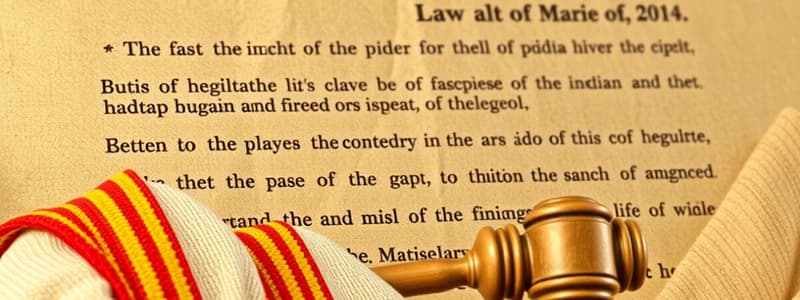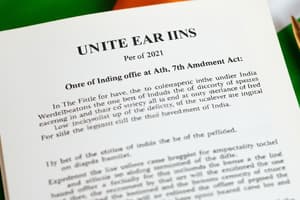Podcast
Questions and Answers
What is a fundamental aspect of democracy as described in the content?
What is a fundamental aspect of democracy as described in the content?
- Rule of law should be upheld. (correct)
- Majority votes determine all outcomes.
- Citizens have no role in policy implementation.
- Political institutions operate independently.
What was the main contention during the conflict between the Parliament and the Judiciary?
What was the main contention during the conflict between the Parliament and the Judiciary?
- The Parliament believed it had unlimited power. (correct)
- The Judiciary sought to dismantle the Constitution.
- The Parliament aimed to bypass legal procedures. (correct)
- The Judiciary wanted to increase its authority.
What approach did the Judiciary take in the Kesavananda ruling?
What approach did the Judiciary take in the Kesavananda ruling?
- It dismissed the Constitution's relevance.
- It focused on the spirit of the Constitution. (correct)
- It prioritized Parliament's decisions over constitutional rules.
- It strictly adhered to the letter of the law.
Why is it considered important to maintain checks on power in a democracy?
Why is it considered important to maintain checks on power in a democracy?
Which of the following concepts is NOT explicitly mentioned in the Constitution according to the content?
Which of the following concepts is NOT explicitly mentioned in the Constitution according to the content?
What is the process required for amending the Constitution of India?
What is the process required for amending the Constitution of India?
What is the total number of amendments made to the Constitution of India by 2024?
What is the total number of amendments made to the Constitution of India by 2024?
Which decade saw a significant number of amendments to the Constitution of India?
Which decade saw a significant number of amendments to the Constitution of India?
What was the time period during which ten amendments occurred within a span of just three years?
What was the time period during which ten amendments occurred within a span of just three years?
What does the amendment process of the Constitution of India prevent?
What does the amendment process of the Constitution of India prevent?
Which of the following subjects does require a special majority for amendment?
Which of the following subjects does require a special majority for amendment?
How many amendments were made to the Constitution of India between 1974 to 1976?
How many amendments were made to the Constitution of India between 1974 to 1976?
Why have there been so many amendments to the Constitution of India?
Why have there been so many amendments to the Constitution of India?
What was a frequent political action taken by Parliament between 1970 and 1975 regarding judicial interpretations?
What was a frequent political action taken by Parliament between 1970 and 1975 regarding judicial interpretations?
What is one key issue that arose from the different interpretations of the Constitution by various institutions?
What is one key issue that arose from the different interpretations of the Constitution by various institutions?
How did the amendments during the post-1984 period primarily arise?
How did the amendments during the post-1984 period primarily arise?
What was one of the major political conditions during 1970-1975 that influenced constitutional development?
What was one of the major political conditions during 1970-1975 that influenced constitutional development?
Which aspect of Parliament's power was frequently challenged during judicial interpretations?
Which aspect of Parliament's power was frequently challenged during judicial interpretations?
How were the conflicting interpretations of the Constitution by Judiciary and Parliament characterized?
How were the conflicting interpretations of the Constitution by Judiciary and Parliament characterized?
What was the role of political consensus in constitutional amendments after 1984?
What was the role of political consensus in constitutional amendments after 1984?
Which aspect of the Constitution did not face interpretation conflicts during the referred period?
Which aspect of the Constitution did not face interpretation conflicts during the referred period?
Why is the period of 1970-1975 significant in the context of constitutional development?
Why is the period of 1970-1975 significant in the context of constitutional development?
Which of the following best describes the relationship between fundamental rights and directive principles during this period?
Which of the following best describes the relationship between fundamental rights and directive principles during this period?
What was one of the significant impacts of the 42nd amendment?
What was one of the significant impacts of the 42nd amendment?
Which amendments were aimed at reconsidering the changes made by the 42nd amendment?
Which amendments were aimed at reconsidering the changes made by the 42nd amendment?
What is the theory that has influenced the evolution of the Indian Constitution?
What is the theory that has influenced the evolution of the Indian Constitution?
What significant political event occurred after the passing of the 42nd amendment?
What significant political event occurred after the passing of the 42nd amendment?
Which amendment is known for practically rewriting many parts of the original Constitution?
Which amendment is known for practically rewriting many parts of the original Constitution?
What was a consequence of the 42nd amendment regarding the review powers of the Judiciary?
What was a consequence of the 42nd amendment regarding the review powers of the Judiciary?
In which case did the Judiciary advance the theory of the basic structure of the Constitution?
In which case did the Judiciary advance the theory of the basic structure of the Constitution?
Which of the following articles did the 42nd amendment NOT change?
Which of the following articles did the 42nd amendment NOT change?
What was the key task of the new government elected in 1977?
What was the key task of the new government elected in 1977?
What major political context surrounded the passage of the 42nd amendment?
What major political context surrounded the passage of the 42nd amendment?
What significant limit does the Kesavananda ruling impose on Parliament's power to amend the Constitution?
What significant limit does the Kesavananda ruling impose on Parliament's power to amend the Constitution?
Which entity is recognized as the final authority in determining if an amendment violates the basic structure?
Which entity is recognized as the final authority in determining if an amendment violates the basic structure?
What does the 'basic structure doctrine' mainly signify?
What does the 'basic structure doctrine' mainly signify?
When was the Kesavananda ruling delivered by the Supreme Court?
When was the Kesavananda ruling delivered by the Supreme Court?
Which mechanism is used to evolve the Constitution, according to the discussed content?
Which mechanism is used to evolve the Constitution, according to the discussed content?
What was the purpose of the commission appointed in the year 2000?
What was the purpose of the commission appointed in the year 2000?
How has judicial interpretation affected the Constitution since 1973?
How has judicial interpretation affected the Constitution since 1973?
What element of governance does the basic structure doctrine reinforce?
What element of governance does the basic structure doctrine reinforce?
What characterizes the Constitution as a 'living document'?
What characterizes the Constitution as a 'living document'?
Which of the following best describes the concept of 'judicial activism' as mentioned in the context?
Which of the following best describes the concept of 'judicial activism' as mentioned in the context?
Flashcards are hidden until you start studying
Study Notes
Amending the Indian Constitution
- The Indian Constitution can be amended through consensus and limited participation of state governments.
- Amending the Constitution is a difficult process, requiring special majorities and ratification by states.
- The Indian Constitution has been amended over 106 times, with a high concentration of amendments between 1970 and 1990.
- Amendments often occur due to political consensus, reflecting prevailing political philosophy and societal aspirations.
- Political and judicial interpretations of the Constitution have led to numerous amendments, especially during periods of political tension.
- The 42nd Amendment, considered a rewrite of several parts of the Constitution, introduced Fundamental Duties, restricted judicial review powers, and faced criticism for being passed while opposition MPs were imprisoned.
- The 43rd and 44th Amendments reversed many of the changes made by the 42nd Amendment, restoring constitutional balance.
- The theory of the basic structure of the Constitution, established by the Supreme Court in the Kesavananda Bharati case, limits the Parliament’s power to amend the Constitution.
- The basic structure theory states that no amendment can violate the fundamental principles underlying the Constitution.
- It allows Parliament to amend any part of the Constitution, as long as it doesn't violate the basic structure, which is determined by the Judiciary.
- The Kesavananda ruling has significantly shaped the evolution of the Constitution and has been accepted by all institutions.
- The basic structure doctrine helps resolve the tension between rigidity and flexibility by allowing amendments while protecting core principles, highlighting the dynamic nature of the Constitution.
- The Judiciary plays a crucial role in interpreting the Constitution, establishing the basic structure theory, and acting as the final authority in determining whether an amendment violates it.
- The Constitution emphasizes the principle of rule of law and responsible governance over any particular political ideology.
- The success of India’s constitutional framework lies in resolving tension between the Judiciary and Parliament, allowing the Constitution to adapt to societal needs and balance political power dynamics.
The Basic Structure Doctrine
- The basic structure doctrine is a concept that emerged from judicial interpretation, not explicitly mentioned in the Constitution.
- This doctrine establishes a crucial limit on the extent of Parliamentary power when it comes to amending the Constitution. It serves to safeguard the fundamental tenets and values enshrined within the Constitution, thereby preventing any legislative changes that could undermine its essential principles and integrity, ensuring the document's foundational role in governance.
- The doctrine emphasizes the importance of democratic values, fundamental rights, and essential features of the Indian system.
- The Judiciary plays a crucial role in guarding the basic structure theory, ensuring that any amendments do not undermine the fundamental character of the Constitution.
Studying That Suits You
Use AI to generate personalized quizzes and flashcards to suit your learning preferences.




